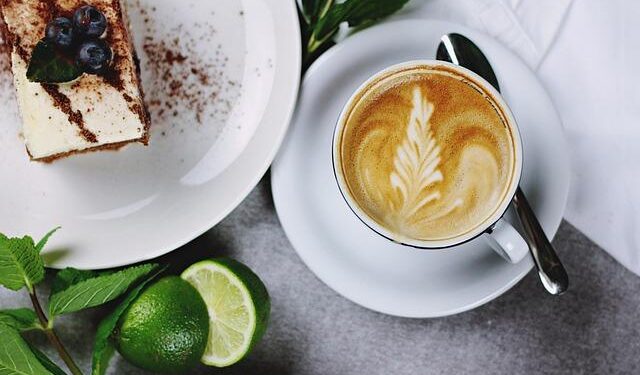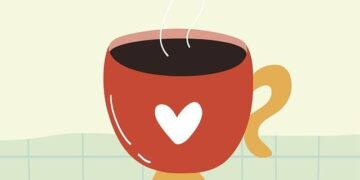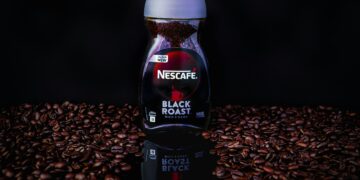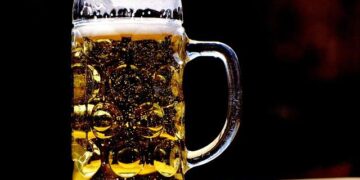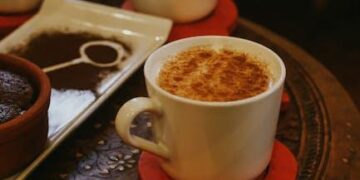Table of Contents
As a food scientist, I’ve spent my career in a world of precision.
I work with grams, percentages, and parts per million.
I trust in the consistency of formulas and the predictability of chemical reactions.
Yet for years, my personal relationship with coffee—the world’s most popular psychoactive beverage—was a chaotic mess.
One morning, a large cup of drip coffee from the office machine would fuel a perfectly productive day.
The next, I’d treat myself to a supposedly “stronger” double-shot latte from a local café, only to feel a disappointing lack of energy.
On a third day, the exact same latte would leave me jittery, anxious, and unable to focus.
I was chasing an energy boost I couldn’t predict, let alone control.
It was a deeply frustrating experience for someone who deals in facts.
Why was the effect so wildly inconsistent?
This personal struggle mirrors a universal one.
A simple search for “how much caffeine in a latte” opens a Pandora’s box of conflicting information.
Some sources claim a modest 63 milligrams 1, others a more robust 128 milligrams 2, and some a formidable 173 milligrams.3
This isn’t just a matter of rounding errors; it’s a chasm of uncertainty that leaves most of us guessing about what we’re really putting into our bodies.
This article is the story of how I, a scientist humbled by a coffee bean, finally cracked the code.
It’s a journey that took me from a state of caffeine-induced confusion to a moment of profound clarity.
By the end, you will not only know the numbers but will possess a powerful mental model to navigate the entire world of coffee.
You will be transformed from a confused consumer into an empowered connoisseur, capable of choosing your daily brew with intention and precision.
Part I: The Great Divide – Unpacking the Latte Paradox
The heart of the confusion lies in a fundamental paradox: a latte is perceived as two completely opposite things at once.
Is it a weak, milky drink for coffee novices, or is it a potent, espresso-based powerhouse?
On one hand, many see it as a gentle introduction to coffee.
The Italian word latte literally means “milk,” and the drink is, by volume, mostly steamed milk designed to soften the intense flavor of espresso.2
It’s often described as a creamy, mild, and smooth beverage, a far cry from the bracing bitterness of black coffee.1
On the other hand, the very presence of “espresso” in the description triggers an assumption of immense strength.
Espresso is the most concentrated form of coffee, and many logically conclude that any drink built upon it must be a high-octane brew to be approached with caution.5
This is not just a matter of opinion; the data itself reflects this paradox.
As noted, the reported caffeine content for a standard latte varies dramatically:
- A 12-ounce latte is cited as having between 63 and 126 milligrams.1
- A 16-ounce latte is often pegged at 128 milligrams.2
- Other sources claim a latte contains as much as 173 milligrams.3
This variance isn’t an error; it’s a clue.
The mystery isn’t in the numbers themselves, but in the factors that create them.
After staring at this conflicting data, I realized the foundational problem: the question “how much caffeine in a latte?” is flawed.
It’s like asking, “How much does a bag of groceries weigh?” The answer depends entirely on what you put in the bag.
A “latte” is not a standardized product like a can of soda.
It’s a recipe, and each ingredient is a variable that can dramatically alter the final caffeine count.
To solve the mystery, we can’t look for a single magic number.
We must become forensic investigators and deconstruct the recipe, starting with its most crucial component: the engine of the latte.
Part II: The Engine of the Latte – A Forensic Look at the Espresso Shot
To understand the whole, we must first understand its core.
The caffeine content of a latte is almost entirely determined by the espresso that goes into it.
The steamed milk is, for caffeine purposes, just a neutral filler.
The espresso shot is the engine, and its specifications dictate the power of the final drink.
The Baseline Number
Before exploring the variables, we need a baseline.
Across numerous independent coffee labs and academic sources, a standard single (1-ounce) shot of espresso made from Arabica beans contains, on average, 63 to 64 milligrams of caffeine.7
Consequently, a “double shot,” or doppio, which is the standard foundation for most lattes in specialty coffee shops, contains approximately 126 to 128 milligrams of caffeine.7
This figure is the most reliable starting point for our investigation.
However, this number is just the beginning of the story, as several powerful factors can cause it to fluctuate wildly.
The Genetic Code: Arabica vs. Robusta
The single most significant variable determining an espresso shot’s potential caffeine content is the type of bean used.
There are two main species of coffee commercially grown: Coffea arabica and Coffea canephora, commonly known as Robusta.
The difference in their caffeine content is staggering: Robusta beans contain almost double the caffeine of Arabica beans.9
By weight, Arabica beans average between 1.2% and 1.5% caffeine, while Robusta beans boast a caffeine content of 2.2% to 2.7%, with some varieties reaching as high as 4%.11
Most high-end specialty coffee shops pride themselves on using 100% Arabica beans, which are prized for their complex, aromatic, and less acidic flavor profiles.12
However, many commercial espresso blends, particularly in Europe and for more budget-conscious brands, incorporate a percentage of Robusta beans.
They do this because Robusta is cheaper, hardier to grow, and produces a thick, stable
crema (the reddish-brown foam on top of an espresso shot).
But the primary trade-off is flavor for potency.
Robusta is known for a more bitter, rubbery, and less nuanced taste.11
This reveals a fundamental choice made by the coffee roaster that directly impacts the consumer.
A latte made with a 100% single-origin Arabica espresso will have a fundamentally different (and lower) caffeine content than one made with a blend containing 20% Robusta, even if both are “double shots.” This “genetic code” of the espresso blend is a hidden variable that explains a huge part of the variance in reported caffeine numbers.
The Roast Myth: Light vs. Dark
One of the most persistent myths in coffee culture is that a dark, “strong-tasting” roast contains more caffeine.16
The logic seems intuitive: darker, bolder flavor must equal more power.
The scientific reality is the opposite.
Caffeine is a very stable molecule, but the intense heat of the roasting process does burn a very small amount of it away.
Therefore, when measured by weight, lighter roasted beans have slightly more caffeine than darker roasted beans.8
So why does the myth persist? The answer lies in the physical changes that happen during roasting.
As beans are roasted darker, they lose moisture and expand, becoming physically larger and less dense.17
This creates the “scoop vs. scale” problem.
- If a barista measures coffee by volume (using a scoop), they will fit fewer dark roast beans into the scoop because they are larger and less dense. Less coffee mass means less total caffeine.
- If a barista measures coffee by weight (using a scale, the standard in any reputable shop), the caffeine difference between a light and dark roast is practically negligible.
The “strength” people associate with a dark roast is a flavor perception, not a caffeine reality.
Dark roasting mutes the bean’s natural acidity and brings out bolder, richer, and smokier flavors, which many people interpret as strength.8
This is a critical distinction that trips up most consumers.
A latte made with a dark roast will taste more “roasty,” but it will not give you a bigger caffeine kick than one made with a light roast, assuming the same weight of coffee is used.
The Brand Factor: A “Shot” Is Not a Standard Unit
Perhaps the most practical and surprising discovery is that the term “espresso shot” is not a standardized unit of caffeine like a milligram or an ounce.
It is a brand-specific serving size, and the differences can be enormous.
While the industry average for a single shot is around 64 mg, major chains operate on their own standards:
- A Starbucks single espresso shot (and the basis for their lattes) contains approximately 75 mg of caffeine.2
- A Dunkin’ single espresso shot contains a massive 118 mg of caffeine.22
This is a monumental source of public confusion.
People understandably assume a “double-shot latte” is a consistent order, but the data proves this is false.
A medium (14 oz) hot latte from Dunkin’, which is based on their espresso, contains 166 mg of caffeine.22
A Grande (16 oz) Caffè Latte from Starbucks, which contains two of their shots, has 150 mg of caffeine.21
The serving sizes are similar, but the caffeine can differ because the foundational “shot” is a completely different product.
To truly know your latte’s caffeine content, you must know the “brand” of the engine powering it.
Part III: The Epiphany – The Concert Hall Analogy
After dissecting the espresso shot, I understood the variables that could change its caffeine content.
But my own inconsistent experiences still puzzled me.
Why did a big cup of drip coffee sometimes feel so much more powerful than a latte that was supposedly built on a “stronger” espresso base? The answer, when it came, was a simple concept that changed everything.
It wasn’t about the espresso shot in isolation; it was about how it compared to other drinks.
The biggest misconception in all of coffee is the confusion between caffeine concentration and total caffeine volume.
- Concentration: The amount of caffeine per unit of volume (e.g., milligrams per ounce).
- Total Volume: The total amount of caffeine in the entire serving you drink.
Espresso has a very high concentration of caffeine, but it’s served in a very small volume.
Drip coffee has a much lower concentration, but it’s served in a much larger volume.
This is the key.
To make this intuitive, I developed an analogy: The Concert Hall.
Imagine you are standing in a vast, empty concert hall.
- The Latte’s Espresso Shot is a Punk Rock Band: In one corner of the stage, a punk rock band is playing. They are crammed into a tiny space, with massive amplifiers stacked high. If you stand right in front of them, the sound is incredibly loud, intense, and concentrated. This is caffeine concentration. An ounce of espresso packs a powerful punch of about 63 mg.8
- The Cup of Drip Coffee is a Symphony Orchestra: Spread across the entire stage is a full 90-piece symphony orchestra. No single instrument—not the violins, not the cellos—is anywhere near as loud as the punk band’s wall of amplifiers. However, the total sound energy from all 90 instruments fills the entire hall with a massive, sustained wave of sound. This is total caffeine. An ounce of drip coffee has only about 12 mg of caffeine, but you drink many more ounces.8
The great deception is that people confuse the loudness in the corner (the intense, concentrated taste of espresso) with the total sound in the hall (the total caffeine dose).
A latte tastes strong because of the concentrated espresso flavor, but a large cup of drip coffee almost always delivers a bigger total dose of caffeine and thus has a more powerful overall effect.
This single mental model explains why a person can feel more “zooted” from a cup of drip coffee than from an espresso-based drink, a common experience among coffee drinkers.24
The numbers bear this out clearly.
Table 1: The Concert Hall Analogy in Numbers
| Beverage | Caffeine per Ounce (Concentration – “The Punk Band”) | Typical Serving Size | Total Caffeine per Serving (“The Orchestra”) |
| Espresso Shot | ~63 mg/oz 9 | 1 oz | ~63 mg |
| Latte (12 oz, 2 shots) | ~10.7 mg/oz (diluted) | 12 oz | ~128 mg |
| Drip Coffee (12 oz) | ~12-16 mg/oz 23 | 12 oz | ~144-192 mg |
| Cold Brew (12 oz) | ~17 mg/oz 25 | 12 oz | ~205 mg |
This table makes the abstract concept concrete.
While an ounce of pure espresso is highly concentrated, once it’s used to make a 12-ounce latte, the overall concentration drops significantly.
A 12-ounce cup of drip coffee, despite its lower concentration, delivers a higher total caffeine payload simply because the entire volume is caffeinated coffee, not mostly milk.
Part IV: The Caffeine Showdown – A Practical Guide to Your Daily Brew
Armed with the Concert Hall principle, we can now definitively answer the practical questions that started this journey.
We can compare the latte to its caffeinated peers and build a real-world guide for making informed choices.
Latte vs. Drip Coffee: The Definitive Answer
In a direct, size-for-size comparison, drip coffee almost always contains significantly more caffeine than a standard latte.
A typical 12- to 16-ounce latte, made with a standard double shot (doppio) of espresso, will contain between 128 and 150 milligrams of caffeine.2
A similarly sized cup of drip-brewed coffee, by contrast, can easily contain
195 to 310 milligrams of caffeine, and sometimes much more, depending on the brew strength and bean type.1
This directly resolves one of coffee’s biggest myths.5
If your goal is the maximum caffeine dose per cup, drip coffee is the clear winner.
Latte vs. The World: A Comparative Snapshot
How does a latte stack up against other common caffeinated beverages?
- Versus Tea: A standard 8-ounce cup of black tea contains around 48 mg of caffeine, while green tea has about 29 mg.26 A typical latte is significantly stronger than a cup of tea. An interesting nuance is that tea contains the amino acid L-theanine, which can modulate the effects of caffeine, often resulting in a calmer, less jittery alertness compared to coffee.27
- Versus Soda: A 12-ounce can of Coca-Cola Classic has about 34 mg of caffeine, and a Mountain Dew has around 55 mg.28 A latte is far more caffeinated than almost any mainstream soda.
- Versus Energy Drinks: This comparison is complex because the energy drink market is highly varied. A small 8.4-ounce can of Red Bull contains 80 mg of caffeine, which is less than most lattes.29 However, many popular energy drinks are sold in 16-ounce cans and can contain anywhere from 150 mg to over 300 mg of caffeine, putting them on par with or even exceeding a large drip coffee.30 The key differences are often the source of the caffeine (naturally occurring in coffee vs. synthetic in many energy drinks) and the presence of other stimulants like taurine and guarana, as well as massive amounts of sugar or artificial sweeteners.31
The Ultimate Cheat Sheet: Your Daily Caffeine Budget
Theory is useful, but practical tools are essential.
The following table breaks down the caffeine content of popular drinks from major chains, contextualizing them within the U.S. FDA’s recommended daily limit of 400 mg for a healthy adult.2
Table 2: Your Daily Caffeine Budget – A Guide to Major Coffee Chains
| Beverage & Chain | Size | Number of Espresso Shots | Total Caffeine (mg) | % of 400mg Daily Guideline |
| Starbucks Caffè Latte | Tall (12 oz) | 1 | 75 mg 25 | 19% |
| Starbucks Caffè Latte | Grande (16 oz) | 2 | 150 mg 21 | 38% |
| Starbucks Caffè Latte | Venti (20 oz) | 2 | 150 mg 20 | 38% |
| Starbucks Pike Place Roast | Grande (16 oz) | N/A | 310 mg 25 | 78% |
| Starbucks Blonde Roast | Grande (16 oz) | N/A | 360 mg 25 | 90% |
| Dunkin’ Hot Latte | Medium (14 oz) | ~1.5 | 166 mg 22 | 42% |
| Dunkin’ Hot Latte | Large (20 oz) | ~2 | 252 mg 22 | 63% |
| Dunkin’ Original Blend Coffee | Medium (14 oz) | N/A | 210 mg 22 | 53% |
| Dunkin’ Cold Brew | Medium (24 oz) | N/A | 260 mg 33 | 65% |
Note: Dunkin’s espresso system is less transparent than Starbucks’.
Caffeine content for lattes is based on their reported total beverage caffeine, not a simple multiplication of their high-caffeine “shot.”
This table provides a clear, actionable guide.
A Grande Latte from Starbucks uses nearly 40% of your daily caffeine budget.
A Grande Blonde Roast from the same shop, however, uses a staggering 90%.
Understanding this difference is the key to mastering your daily intake.
Part V: The Aftermath – Debunking Lingering Myths
Once the main mystery is solved, a few secondary questions naturally arise.
Let’s address them directly.
Does Milk Really Reduce Caffeine?
No. This is a common point of confusion.
Adding milk to coffee does not chemically neutralize or remove caffeine molecules.
It simply dilutes the beverage, increasing its total volume and reducing the caffeine concentration (the “punk band” gets quieter because the hall gets bigger).34
If you drink the entire cup of coffee with milk, you will consume the exact same total amount of caffeine as if you had drunk the coffee black.36
However, milk does have other effects.
It can lower the overall acidity of the coffee, which may make it gentler on a sensitive stomach.
The proteins and fats in milk can also bind with tannins in coffee, which may help reduce teeth staining.35
Recent molecular research confirms that while milk proteins and coffee compounds interact, the fundamental structure of the milk proteins remains intact, preserving their mouthfeel, and they do not appear to significantly alter caffeine’s bioavailability.37
The takeaway: milk changes the taste, texture, and concentration of your coffee, but not the total caffeine dose.
What About Flavors? The Mocha Exception
Most flavored syrups used in lattes, such as vanilla, caramel, or hazelnut, are caffeine-free.
They add sugar and calories, but not stimulants.
The major exception is mocha.
A mocha is simply a latte with chocolate syrup added.
Since chocolate is derived from the cacao plant, it naturally contains a small amount of caffeine.3
This adds a measurable boost to the drink.
For example, a Grande Caffè Mocha from Starbucks contains 175 mg of caffeine, compared to the 150 mg in a standard Grande Caffè Latte.
That extra 25 mg comes directly from the chocolate.20
Can I Get a Decaf Latte?
Absolutely.
Any latte can be made using decaffeinated espresso beans.2
This is an excellent option for those who enjoy the flavor and ritual of a latte in the evening or are sensitive to caffeine.
However, it is crucial to understand that “decaf” does not mean “caffeine-free.” The decaffeination process, whether using water (like the Swiss Water Process) or chemical solvents, removes about 97% of the caffeine, but not 100%.16
A decaf espresso shot will still contain a small residual amount of caffeine, typically in the range of 2 to 15 milligrams.9
For most people, this amount is negligible.
But for individuals with extreme caffeine sensitivity or specific medical conditions requiring zero caffeine intake, even this small amount can be relevant.
Conclusion: From Confused Consumer to Empowered Connoisseur
My journey through the caffeine maze began with frustration and ended with clarity.
The chaotic, unpredictable effects of my daily coffee were not random; they were the logical output of a system I simply didn’t understand.
By deconstructing the latte and discovering the “Concert Hall” principle, I transformed my relationship with coffee.
I was no longer a victim of its whims.
I could now choose my drink with intention.
You now possess this same knowledge.
The “Latte Deception” is over.
You are equipped with a simple yet powerful toolkit to master your own coffee ritual.
The next time you walk into a coffee shop, you can look at the menu not with confusion, but with understanding.
You now know to think beyond the simple name of a drink and consider the key principles:
- The Engine is the Shot: A latte’s caffeine content is dictated by the number, type, and brand of the espresso shots that form its base.
- Know Your Brand: A “shot” from Starbucks (~75 mg) is not the same as a “shot” from Dunkin’ (~118 mg). This brand-specific knowledge is critical.
- Remember the Concert Hall: Do not confuse the concentrated taste of espresso with total caffeine. In a size-for-size showdown, a large cup of drip coffee delivers a much bigger total caffeine dose than a standard latte.
- Milk Dilutes, It Doesn’t Delete: Adding milk makes the drink weaker in concentration and milder in taste, but you still consume the full caffeine payload of the espresso shots within.
With this framework, you can now make a deliberate, informed choice that perfectly suits your energy needs for the day.
Whether you need the long, steady burn of a drip coffee, the reliable medium boost of a Starbucks double-shot latte, or the gentle lift of a single-shot afternoon treat, the choice is now yours to make with confidence and precision.
Works cited
- Exploring the Caffeine Content of Various Coffee Drinks | Lingonberry Roastery & Bakery, accessed August 6, 2025, https://www.lingonberrycafe.com/s/stories/exploring-the-caffeine-content-of-various-coffee-drinks
- How Much Caffeine Is In a Latte? More Than You’d Think | Corner Coffee Store, accessed August 6, 2025, https://cornercoffeestore.com/how-much-caffeine-in-a-latte/
- How much caffeine is in a latte? – Coffee Bean Shop, accessed August 6, 2025, https://coffeebeanshop.co.uk/blogs/news/how-much-caffeine-is-in-a-latte-the-coffee-bean-shop-caffeine-guide
- Latte vs Coffee What Really Fuels You Better – JavaPresse, accessed August 6, 2025, https://www.javapresse.com/blogs/enjoying-coffee/latte-vs-coffee-what-really-fuels-you-better
- DISPELLING COFFEE MYTHS AND MISCONCEPTIONS – Coffee …, accessed August 6, 2025, https://coffeehero.com.au/blogs/news/dispelling-coffee-myths-and-misconceptions
- Caffeine Myths: Espresso vs Drip Coffee – Kicking Horse Coffee – USA, accessed August 6, 2025, https://kickinghorsecoffee.com/pages/caffeine-myths-espresso-vs-drip-coffee
- Caffeine in Lattes vs Coffee: Unraveling the Differences, accessed August 6, 2025, https://majestycoffee.com/blogs/posts/caffeine-in-lattes-vs-coffee
- Coffee versus Espresso: Unraveling the Caffeine Mystery, accessed August 6, 2025, https://www.compasscoffee.com/blogs/the-daily-grind/coffee-vs-espresso-unraveling-the-caffeine-mystery
- The Ultimate Guide to Understanding the Caffeine Content in Coffee and Espresso, accessed August 6, 2025, https://cliffandpebble.com/blogs/our-blog/how-much-caffeine-in-a-shot-of-espresso-unveiling-the-facts
- How Much Caffeine Is in a Shot of Espresso? – OutIn, accessed August 6, 2025, https://outin.com/blogs/news/espresso-caffeine-content
- Why you should Drink Robusta Coffee Beans, accessed August 6, 2025, https://stonestreetcoffee.com/blogs/brooklyn-coffee-academy/robusta-is-the-most-caffeinated-coffee-bean-type-and-if-you-re-not-drinking-it-you-re-missing-out
- How Much Caffeine is in Coffee? – Driftaway Coffee, accessed August 6, 2025, https://driftaway.coffee/coffee-with-most-caffeine/
- stonestreetcoffee.com, accessed August 6, 2025, https://stonestreetcoffee.com/blogs/brooklyn-coffee-academy/robusta-is-the-most-caffeinated-coffee-bean-type-and-if-you-re-not-drinking-it-you-re-missing-out#:~:text=Arabica%2C%20the%20most%20popular%20coffee,and%20more%20naturally%20bitter%20flavor.
- Caffeine in coffee – Coffeetime – FreeFlarum, accessed August 6, 2025, https://coffeetime.freeflarum.com/d/1315-caffeine-in-coffee
- Arabica vs Robusta Coffee Difference (Mysterious Details Revealed), accessed August 6, 2025, https://balancecoffee.co.uk/blogs/blog/robusta-vs-arabica-coffee
- The most common myths, misconceptions, and factoids about coffee that even the most devout coffee lovers get wrong., accessed August 6, 2025, https://www.compasscoffee.com/blogs/the-daily-grind/common-coffee-myths
- 5 Common Myths and Misconceptions in the Coffee Shop, accessed August 6, 2025, https://www.coffeelabevanston.com/post/5-common-myths-and-misconceptions-in-the-coffee-shop
- The Hidden Truth About Caffeine in Lattes – JavaPresse Coffee Company, accessed August 6, 2025, https://www.javapresse.com/blogs/enjoying-coffee/the-hidden-truth-about-caffeine-in-lattes
- Caffeine level : r/Coffee – Reddit, accessed August 6, 2025, https://www.reddit.com/r/Coffee/comments/1fxjpyh/caffeine_level/
- Starbucks Caffeine: 24 Drinks Ranked by Caffeine Content | Corner Coffee Store, accessed August 6, 2025, https://cornercoffeestore.com/starbucks-caffeine-guide/
- Caffè Latte: Nutrition: Starbucks Coffee Company, accessed August 6, 2025, https://www.starbucks.com/menu/product/407/hot/nutrition
- Dunkin’ Donuts Coffee Guide: History , Caffeine Content & Best Drinks, accessed August 6, 2025, https://cornercoffeestore.com/dunkin-donuts-coffee-caffeine-content/
- Understanding the Caffeine Intake in Drip Coffee vs. Espresso – CNET, accessed August 6, 2025, https://www.cnet.com/home/kitchen-and-household/understanding-the-caffeine-intake-in-drip-coffee-vs-espresso/
- Do different coffee drinks hit y’all differently? : r/barista – Reddit, accessed August 6, 2025, https://www.reddit.com/r/barista/comments/1h0sk8l/do_different_coffee_drinks_hit_yall_differently/
- How Much Caffeine in a Cup of Starbucks Coffee? – CAFELY, accessed August 6, 2025, https://cafely.com/blogs/info/how-much-caffeine-starbucks-coffee
- Caffeine content for coffee, tea, soda and more – Mayo Clinic, accessed August 6, 2025, https://www.mayoclinic.org/healthy-lifestyle/nutrition-and-healthy-eating/in-depth/caffeine/art-20049372
- Caffeine And Tea – Your Guide To Caffeine Content In Tea (vs Coffee) – Adagio Teas, accessed August 6, 2025, https://www.adagio.com/info/caffeine_and_tea.html
- Coffee, Tea, Soft Drinks — Caffeine Content – Utah Math Department, accessed August 6, 2025, https://www.math.utah.edu/~yplee/fun/caffeine.html
- Red Bull vs Coffee: Moderation Is Key!, accessed August 6, 2025, https://www.coffeeness.de/en/red-bull-vs-coffee/
- How much caffeine is in coffee, tea, soda, and other foods?, accessed August 6, 2025, https://www.cspi.org/article/how-much-caffeine-coffee-tea-soda-and-other-foods
- Are Energy Drinks More Harmful Than Coffee? – University Hospitals, accessed August 6, 2025, https://www.uhhospitals.org/blog/articles/2023/08/are-energy-drinks-more-harmful-than-coffee
- Coffee vs Energy Drinks: Pros and Cons, accessed August 6, 2025, https://zavida.com/blogs/coffee-methods/coffee-vs-energy-drinks-pros-and-cons
- How Much Caffeine in Dunkin Frozen Coffee? Content per Brew – CAFELY, accessed August 6, 2025, https://cafely.com/blogs/info/how-much-caffeine-dunkin-frozen-coffee
- caffeinedojo.com, accessed August 6, 2025, https://caffeinedojo.com/does-adding-milk-to-coffee-reduce-caffeine/#:~:text=The%20action%20of%20adding%20milk,having%20your%20coffee%20every%20day.
- Does Adding Milk To Coffee Reduce Caffeine? (No And Here’s Why), accessed August 6, 2025, https://caffeinedojo.com/does-adding-milk-to-coffee-reduce-caffeine/
- Does adding milk to coffee make it less effective caffeinewise : r/NoStupidQuestions – Reddit, accessed August 6, 2025, https://www.reddit.com/r/NoStupidQuestions/comments/y4dqth/does_adding_milk_to_coffee_make_it_less_effective/
- How milk proteins interact with caffeine in espresso – ScienceDaily, accessed August 6, 2025, https://www.sciencedaily.com/releases/2024/06/240606152210.htm
- How milk proteins interact with caffeine in espresso – American Chemical Society, accessed August 6, 2025, https://www.acs.org/pressroom/presspacs/2024/june/how-milk-proteins-interact-with-caffeine-in-espresso.html
